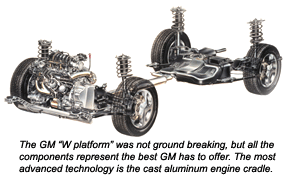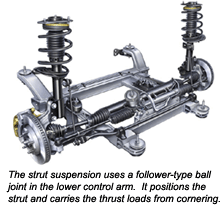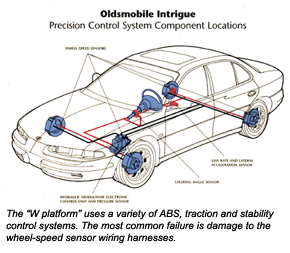The 36-month or 36,000-mile, which ever comes first, bumper-to-bumper warranty has or will expire soon for the 2004 and 2005 General Motors “W platform” vehicles. Many owners of these vehicles will be looking to you for service and repairs.
 The “W platform” was first designated as the GM10 in 1988. In September of 1997, the GM10 was updated from the 108 inch (2,743 mm) wheelbase to the “W platform” with the 109 inch (2,769 mm) wheelbase for the Buick Century/Regal and the Oldsmobile Intrigue. The Chevy Monte Carlo was updated in 2001 to the 109 inch (2,769 mm) wheelbase.
The “W platform” was first designated as the GM10 in 1988. In September of 1997, the GM10 was updated from the 108 inch (2,743 mm) wheelbase to the “W platform” with the 109 inch (2,769 mm) wheelbase for the Buick Century/Regal and the Oldsmobile Intrigue. The Chevy Monte Carlo was updated in 2001 to the 109 inch (2,769 mm) wheelbase.
2000 also saw the reintroduction of the Impala badge with a 110.5 inch (2,808 mm) wheelbase. GM also introduced a 9C1 police package for the Impala which brought GM back into the police fleet sales after killing the rear-wheel drive Impala in 1995.
The 2005 model year, GM introduced Pontiac Grand Prix and the Buick La Crosse with the 110.5 inch (2,808 mm) wheelbase.
Like all vehicles, potholes and broken concrete wreak havoc on wheels tires and suspension parts. Also, road debris, such as truck tire treads and other projectiles can damage undercar components including the CV joint, steering rack boots and brake lines due to their location on these models.
Oil Life System
Little things can mean a lot. Preventive maintenance and inspection are low cost methods of making a vehicle safe and last longer. Oil changes are moving from a 3,000-mile change recommendation to an algorithm in the ECM.
Lack of oil damage is not covered under warranty. The following is a notice from the owners manual: “NOTICE: It is important to check your engine oil regularly and keep it at the proper level. Failure to maintain proper oil level can result in expensive engine repairs not covered by the vehicle warranty.”
The GM 1998 model year saw the introduction of the Change Oil Light and Change Engine Oil message on the Driver Information Center (DIC). The GM Oil Life System is based on an algorithm that was developed from vehicle test data. It uses engine coolant temperature to calculate engine oil temperature and RPM to determine power strokes or combustion events for a given engine to determine oil degradation.
The oil life algorithm is based on the use of SAE 5W 30 motor oil. It is important to use the recommended weight and grade oil to prevent engine damage. A document explaining the process involved can be obtained at Goodwrench.com and searching “oil life system.”
Resetting the light can vary from model to model. Some models involve depressing the gas pedal three times in five seconds. Others may involve a button on the fuse block or pressing a few buttons in a certain sequence on the driver information center.
The information should be in the owner’s manual, but the procedures are also available on most repair information databases.
Tire Inflation Sensitivity
A study released by the National Highway Traffic Safety Administration (NHTSA) indicated that more than one-fourth of passenger car tires on the road are under-inflated. The Car Care Council and NHTSA recommend that tire pressure should be checked once a month. OK, so much for recommendations.
 It is no secret that right tire pressures can make for the best possible ride and handling. The GM “W platform” uses a variety of tire and wheel packages from 14-inch rims to low-profile 18-inch wheel options. It is important to make sure the pressures match the vehicle and wheel package.
It is no secret that right tire pressures can make for the best possible ride and handling. The GM “W platform” uses a variety of tire and wheel packages from 14-inch rims to low-profile 18-inch wheel options. It is important to make sure the pressures match the vehicle and wheel package.
One of the best customer satisfaction services you can perform on these models is to check the inflation pressure per the sticker located on the driver’s door and record them on the repair order. Both the checked pressure and the corrected inflated pressure should be recorded.
Beginning with the 2005 model year, a standard label mandated by the Department of Transportation (DOT) is placed in the driver’s doorsill area. It shows the proper tire sizes and inflation pressure. This label is the same for all vehicles sold in the U.S., no matter the manufacturer.
UnderCar Inspection
Inspecting the boots on the drive axle, steering rack, ball joints and tie rods for tears and damage could save a much more expensive repair.
A piece of road debris can damage these boots if it is deflected into the suspension. They can also cause damage to the catalytic converter and exhaust system.
Front Suspension and Cradle
Cradles aren’t what they used to be. In 2000, the Impala received an aluminum cradle consisting of extruded and die-cast parts. There are two alignment holes on the passenger side of the cradle that align the cradle to the body.
A check of cradle alignment is a good prerequisite for any alignment. Check your service information for the proper procedure to check and align the cradle. Signs of a cradle problem include caster and camber angles that are out of spec.
When checking suspension components, start on the passenger side first. The passenger side is subject to more stress from potholes and curb impacts than the driver’s side. The passenger side will also encounter more road splash and debris.
These conditions will place more stress on the tie rod ends primarily at the rack gear end. The owner may complain that the steering wheel will shake between 45 and 50 miles per hour. This is an indication of a tie rod that is loose at the rack. Turning the steering wheel an inch in either direction and observing the tie rod can confirm this.
The tie rod end boots should be inspected for damage and water intrusion. This can be accomplished by using a putty knife to depress the boot.
The strut suspension uses a follower-type ball joint in the lower control arm. It positions the strut and carries the thrust loads from cornering.
To check the joint, the Belleville washer or spring is loaded or compressed to check for axial endplay. Place a jack stand under the cradle to allow the strut to fully extend. Attach the dial indicator clamp to the lower control arm and locate the dial in a vertical position on the knuckle. Place a jack under the ball joint and load the joint by raising the jack.
 On these vehicles, a road test will tell you more about the condition of the struts than a visual inspection. New struts can improve the vehicle’s performance dramatically.
On these vehicles, a road test will tell you more about the condition of the struts than a visual inspection. New struts can improve the vehicle’s performance dramatically.
The good new about this platform is that GM got rid of the fiberglass/composite leaf spring in the rear. These units cause a lot of noise and ride height problems.
Remember to check the sway bar links. If these joints are worn, they can cause an knocking noise that can be heard by the driver. The OE sway bar links typically use joints that have plastic bushings that can wear rapidly. Some aftermarket links have greaseable joints that can last longer.
Steering
The power steering uses a loop of tubing for a cooler. This loop of tubing is attached to the front of the cradle. Any restrictions in this line can cause power assist problems. The pinch bolt for the yoke that connects the column to rack should be checked for proper position and torque.
Disc brakes on 109 inCh wheelbase vehicles
Vehicles were produced with lower than specified torque on both front brake calipers to steering knuckle attachment bolts. With the improper torque setting, the bolts may not be adequate to prevent movement between the caliper bracket and knuckle.
Brake wear and ABS service
When checking brake pad wear and condition, check the passenger side first. The most vulnerable component of the ABS system is the wheel-speed sensor wiring and connector. Check that the connector and wiring are properly secured and routed properly. Checking the brake fluid level can give an indication of pad wear if the master cylinder has not been topped off.
Technical Service Bulletins and Campaigns
Campaigns are Federal mandated repairs for emissions and safety. Campaigns are the property of the manufacturer’s and car dealer’s service department. The service that you can perform for your customer is to check the Vehicle Identification Number (VIN) to see if the vehicle is part of the recall and check under the hood for a campaign sticker.
If the sticker is not present, ask the owner if they received a notification about the recall. It is the responsibility of the owner to have the campaign repair performed. Remind the owner that the campaign is to be performed at no charge. Even if a vehicle is headed for scrap, it is the responsibility of the dealer to perform the campaign repair and report it to NTHSA.
A TSB and campaign search of your service database can be a shortcut to a diagnosis of a problem. If the vehicle is in the 36-month or 36,000-mile warranty the repair is usually covered by the manufacturer.







